Created by Hana Tadesse, Julia Jorgensen, Khuyen Le, Shana Hadi
Artists’ Statement
Hitched without a Hitch is a turn-based, tabletop role-playing game designed to strengthen friendships as you create a wedding-themed story together.
Become the Baker, Bartender, DJ, or Florist, and experience the challenges and joys of carrying out your job at a small-town wedding. Fulfill your career-enhancing goals, act out your whimsical backstory, and collaborate with other vendors to create a cohesive and successful event. But watch out — you won’t have time to do everything, so you will have to strategically choose your actions!
Whether you lean more towards roleplay or token-gathering strategy, this game can be tailored to your tastes.
Concept Map
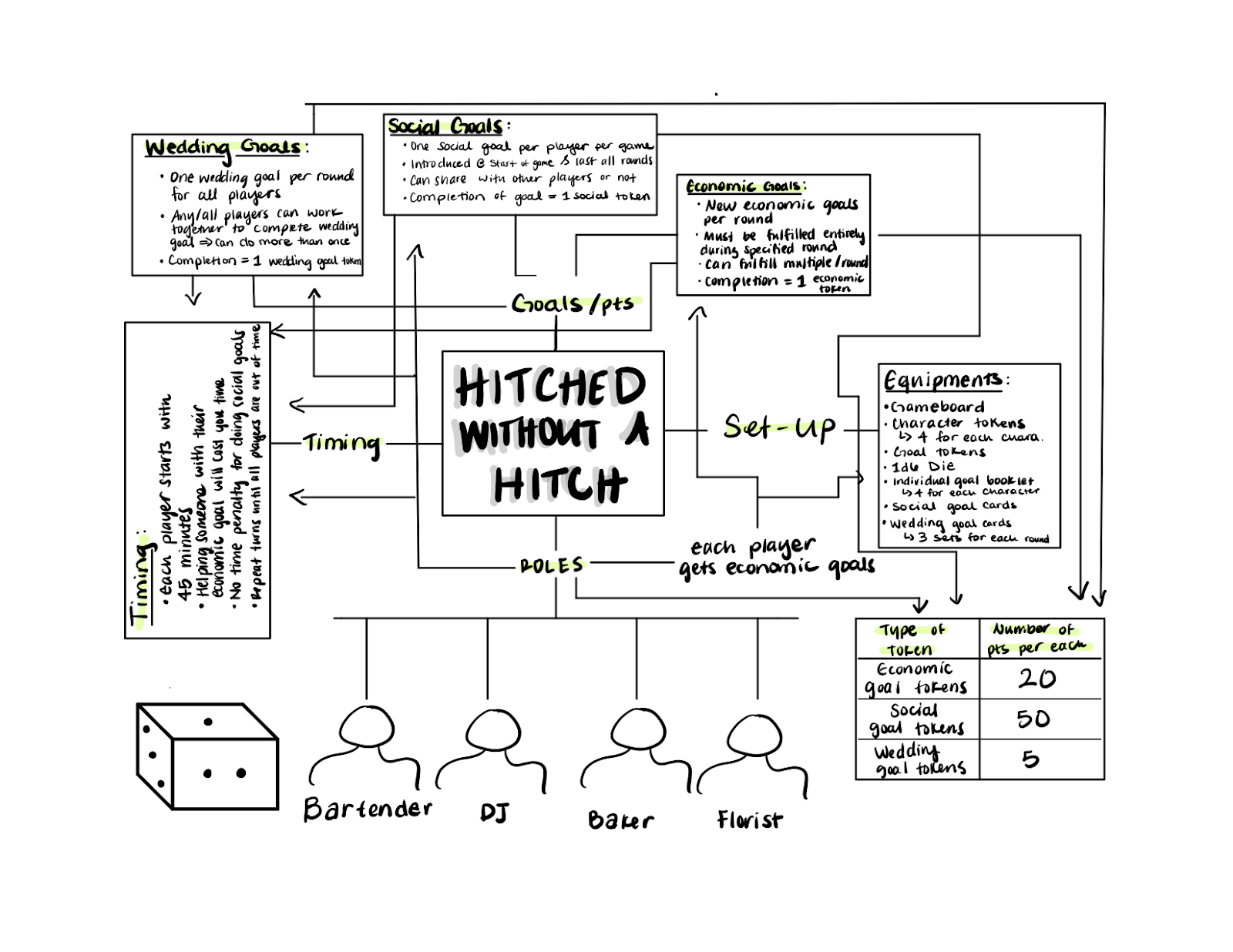
Ideation Exploration

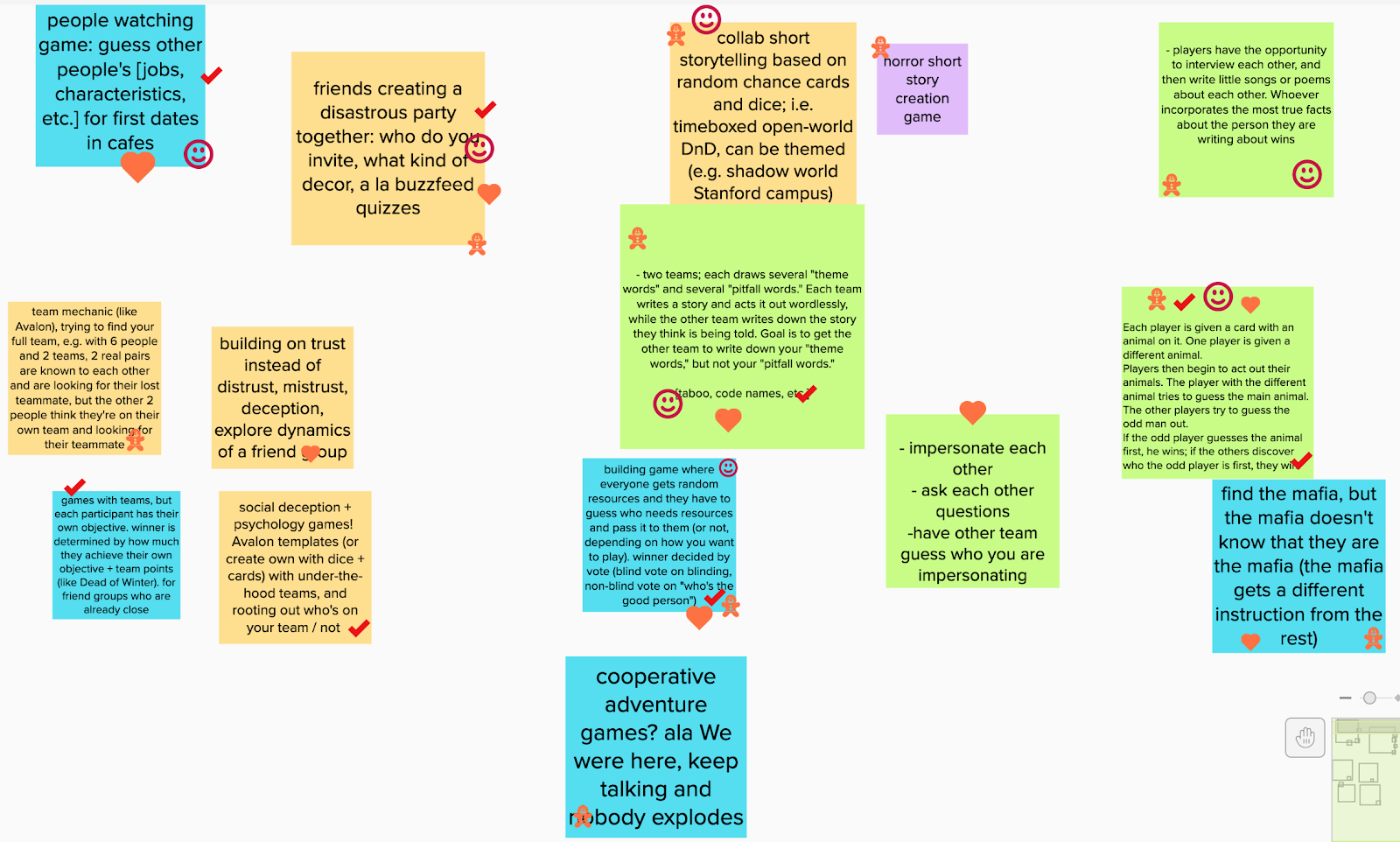
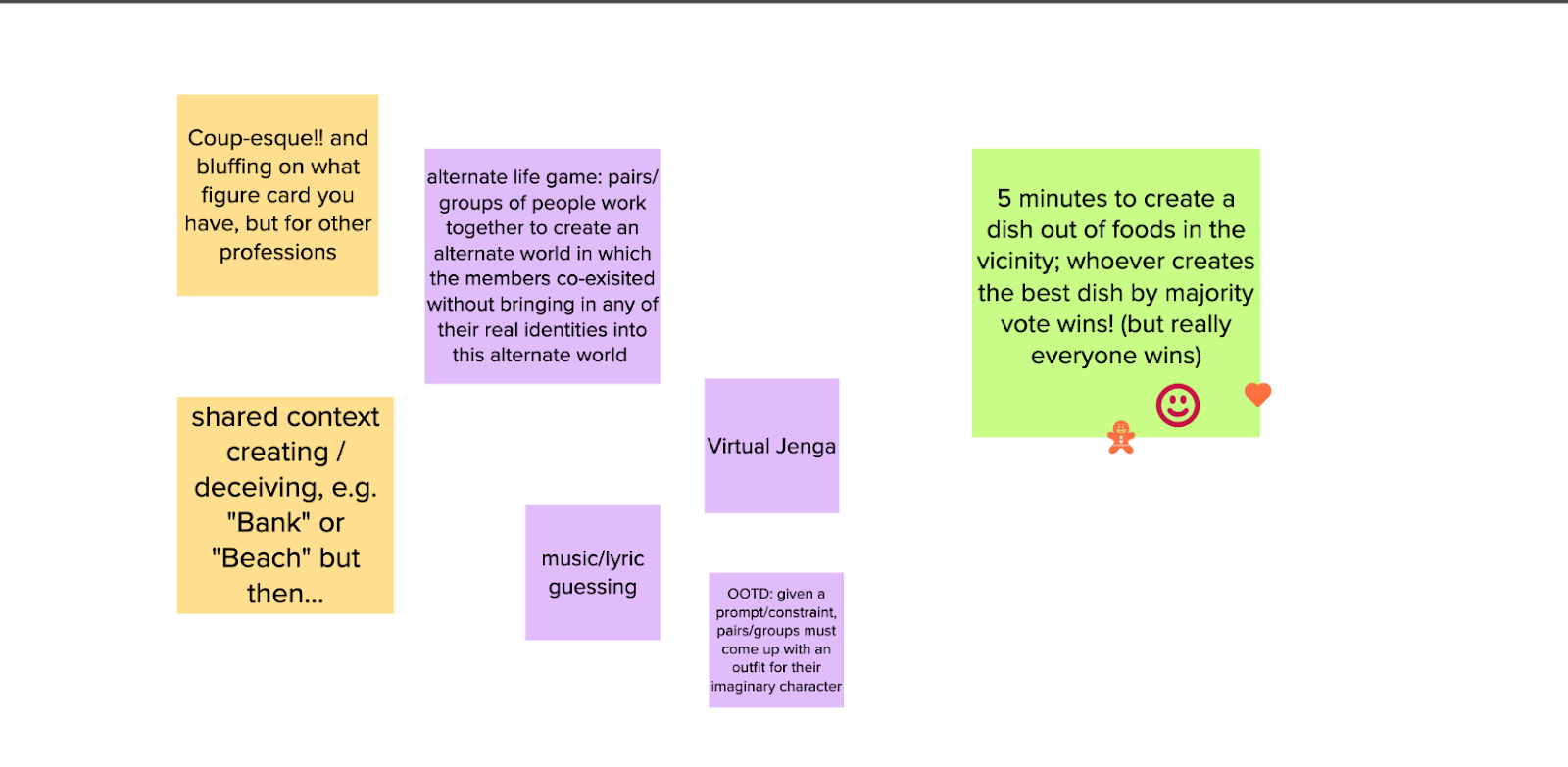
Initial decisions about formal elements and values
We aimed to design a social mediation game that builds friendships and encourages self-expression without relying on bluffing or social deception to undercut other players. We incorporated role-playing and storytelling as forms of competition (balancing different character desires in a conversation) and lighthearted narrative fun (creating a wedding-themed backstory together and saying actions out loud). In doing so, we challenge players to balance competition and collaboration by pursuing group goals and individual goals simultaneously. We also strived to make this a GM-less game where every player contributes backstory and narrative details so that every player feels like they have a stake in the story’s success.
Players: 4 players. We decided on this number of players so we could design a rich story experience for all of the characters.
Player Dynamic: Collaboration and multilateral competition. One of our key design choices is to balance these two dynamics so that players are rewarded equally for both.
Outcomes: The player with the most points at the end of the game wins.
Objectives: Construction. Players construct and manage a narrative for a wedding. They are also managing a “resource” (time) while trying to gain as many tokens / points as possible. This involves talking and even trading favors with other players.
Rules / Procedures: Please see this manual (included in our game box) for complete rules and procedures. (Please note that these rules have been updated based on our rounds of playtesting.)
Boundaries: Our initial design was that this would be a LARP-like game and the boundaries would be any space the players inhabit. However, after playtesting, we felt more confident in designing a tabletop game. Therefore, the boundaries are the shared gameboard that players use to keep track of their times, as well as the limits of their narrative construction.
Values: Hitched Without A Hitch has the core aesthetics of Fellowship, Expression, Fantasy, and Narrative fun. For Fellowship, this game challenges players to collaborate with each other to create a successful wedding. For Fantasy and Expression, players take on the identities of vendors and can express themselves and indulge in their flights of fancy as they add new details to their characters and act however they wish. And for Narrative, because players collaborate on deciding the wedding backstory and how they interact with each other, players build the storyline of the wedding.
The game also cultivates Challenge fun, as players must strategically decide which goals to pursue on each turn. Players also face the obstacle of other players placing demands on their time.
Testing and Iteration History
Playtest 0
Our first prototype that we tested on ourselves used gather.town as a social bricolage tool to mimic the format of a Live Action Role Play (LARP) environment. The game had 5 rounds, and each round lasted for 5 real minutes where all players moved simultaneously and could congregate with others privately to complete their economic, social, or wedding goals.
More details can be found in our Checkpoint 1 submission.
Playtest 1 (with classmates over gather.town)
Key Insights:
- Physical interaction (between avatars on gather.town) is not necessary! We found that the gather.town setting distracted players from strategizing for their actual actions and goals, as they spent precious time maneuvering their avatars in the gather.town space to carry out actions, and had trouble keeping track of their points on the shared document.
- During this playtest, we relied on a moderator to share her screen and distribute roles to individual players via direct messages. Since we want our game to be GM-less, we needed a way for players to track progress on their individual and group information themselves.
Playtest 2 (with classmates over Zoom)
What Changed:
- We eliminated the gather.town component and ran the game on Zoom.
- To address the issue of a moderator controlling all the information, we created a slide deck that explained the rules and procedures of the game and gave everyone access.
- We also created and privately messaged separate “booklets” of economic and social goals to each player.
Key Insights:
- Running the game on Zoom allowed players to complete actions faster than before. It also allowed us to avoid wasting time explaining how gather.town works.
- Players asked many questions about the gameplay (e.g. if they could complete multiple goals at once, or how to accomplish their actions via role-play), suggesting that we needed to further clarify the rules.
- Each round took a long time, as each action took up only a small fraction of sixty “story” minutes, and each player needed to get through sixty minutes.
Playtest 3 (with classmates over Zoom)
What Changed:
- To make the game fairer, we standardized players’ economic goals with regards to the average minutes and other players required. In the goals’ descriptions, we also wrote specific instructions on how to accomplish the goals (e.g. “narrate what happened and ask the group for help!”).
- We shortened the game from 5 to 3 rounds, and reduced the 60 (story) minutes per round to 30 (story) minutes per round. We decreased the time required for each goal accordingly.
- We made talking a free action. That is, we allowed players to fulfill their “talking” social goals (e.g. goals that only require telling another player about themselves) through role-play, while fulfilling goals that require story time (e.g. baking a pastry).
- We merged social goals with revelations (an early prototype of character backstory cards) and revealed them to players at the start of round 2. Players who role-played the backstories on the cards would earn 50 points.
- We asked players to track their time and points individually.
Key Insights:
- Making talking actions free allowed for more streamlined game-play mechanics, since there were fewer factors for players to consider when managing their story time.
- The specific directions on the goal cards (“Describe one van trip you took with a newlywed”) helped players act more decisively and role-play earlier in the game.
- Players did not know who to ask to help with their goals because they could not see how much time other players had left.
- During round 1, players had little reason to talk to others because there were no social goals until round 2. This detracted from the Fellowship aesthetic of the game.
- Players had to calculate and keep track of their points after every turn, which slowed the game, took them out of their roles (detracted from Fantasy), and reduced their engagement.
Playtest 4 (over Zoom among ourselves)
What Changed:
- We designed a game board that all players shared so everyone could track their own remaining time, as well as everyone else’s.
- We pivoted to using tactile tokens for players to track points, instead of writing down numbers after every turn. Now, there are three types of tokens: Wedding (5 points), Economic (20 points), and Social (50 points). Players receive tokens upon completion of their goals. Point calculations now happen at the end of the game and are simply based on how many of each type of token players have.
Key Insights:
- Players were able to track how much time other players have, which helped them direct their requests for help with their goals to a person with available time. Players could also track who had the most points, and try to “waste” that player’s time specifically.
- 30 mins per round was too short for the length of the goals.
Playtest 5 (in-person with a physical game board, printed cards, and tactile tokens, by four pod-mates who are experienced role-players but had never seen our game before)
What Changed:
- We made our documentation detailed enough so the game could be played GM-less, and added an initial worldbuilding “warm-up” in the rules so players could have a no-stakes collaboration by deciding the wedding couple’s name, theme, and love story.
- We moved the Social Goals to the beginning of the game to encourage narrative fun and player interaction through all 3 rounds of the game (“talking is a free action”).
- We adjusted the story-time per round to 45 minutes, and shifted goal time-length accordingly.
Key Insights:
- Players found it natural to create their own characters’ backgrounds and personalities, and collaborated on an elaborate story about the newlyweds’ background.
- Players also naturally bartered between themselves for favors (helping another player in order to get help from them during your turn).
- Players felt that collaboration should be more valued (e.g. helping other players could grant them 1 wedding token, since the game encourages socialization and positive relationships).
- Some players felt impatient while waiting for their turn. We could alleviate this by emphasizing that players can interject in other players’ turns.
Final prototype: Navigate to this folder to access everything you need to play our game!
(Please read our manual before playing. The manual also includes instructions on how to print the play materials!)
Full Playtest (Stanford login only) You can find the full playtest video here.
Design mockups
Game Box Cover (flat and 3D):
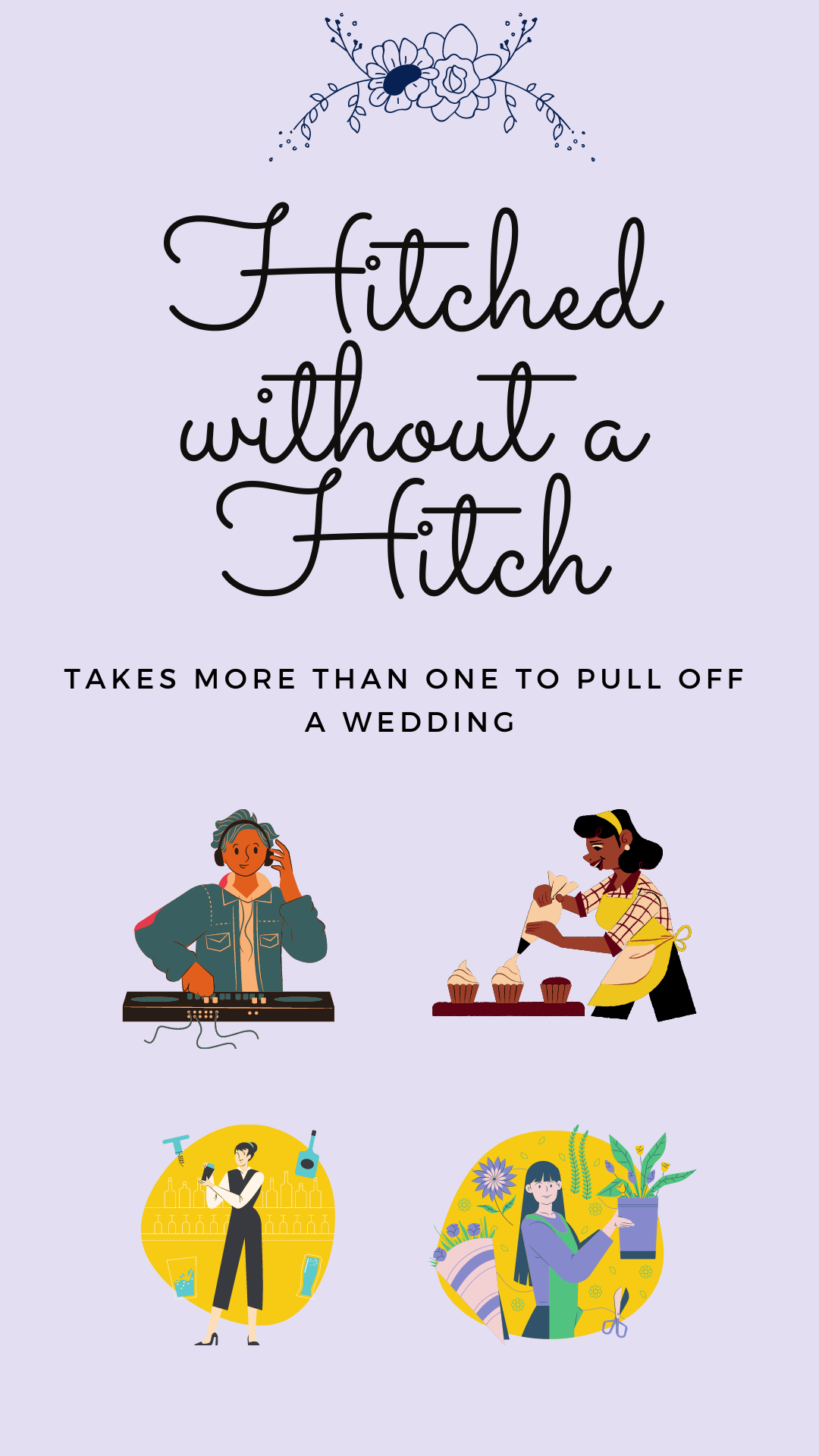

Gameboard (tracks how much time each player has left):
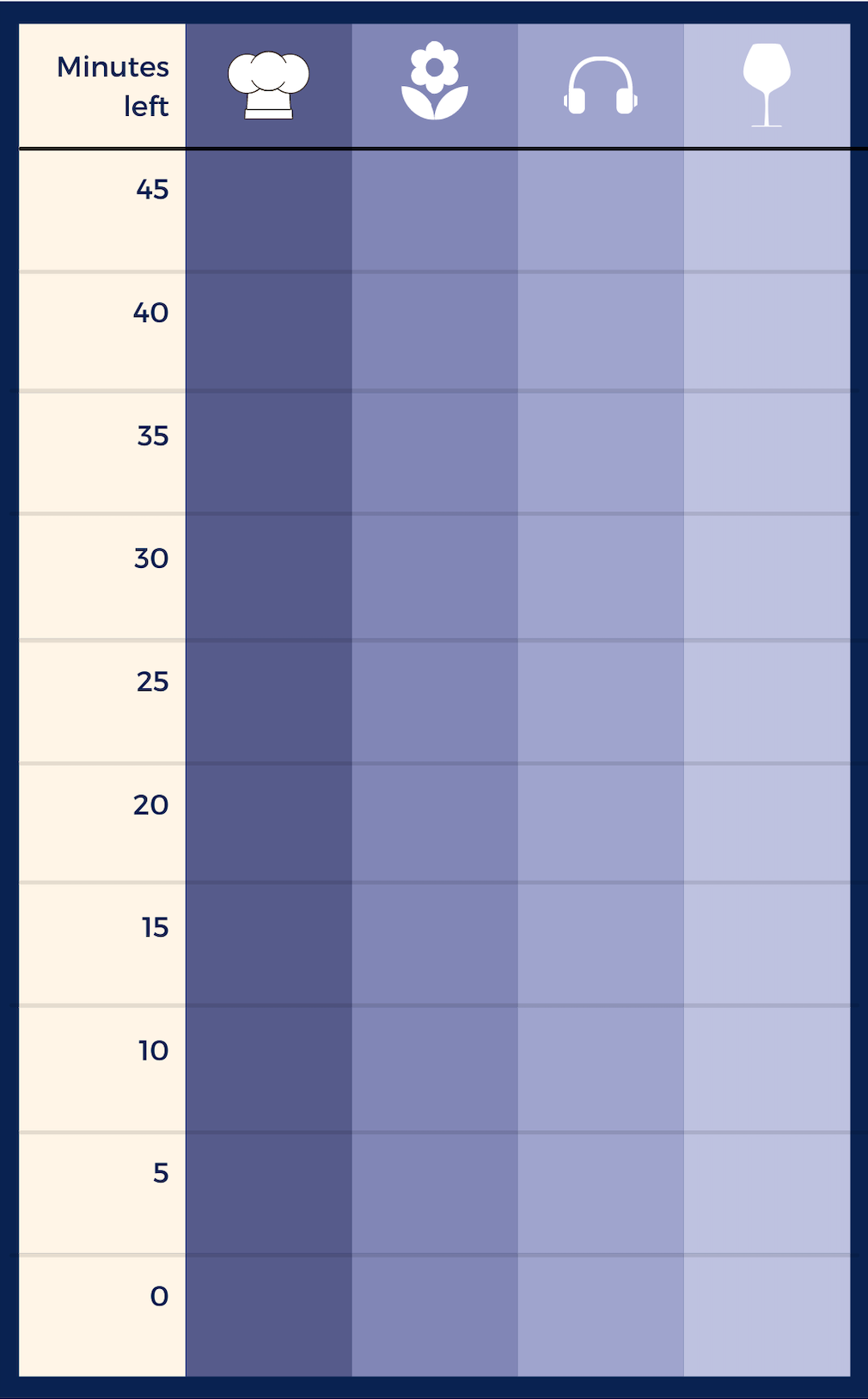
Character tokens (Left to right, top to bottom: florist, bartender, baker, DJ):




Economic Goal Booklet (see all Economic Goal Booklets here (on Google Doc)):
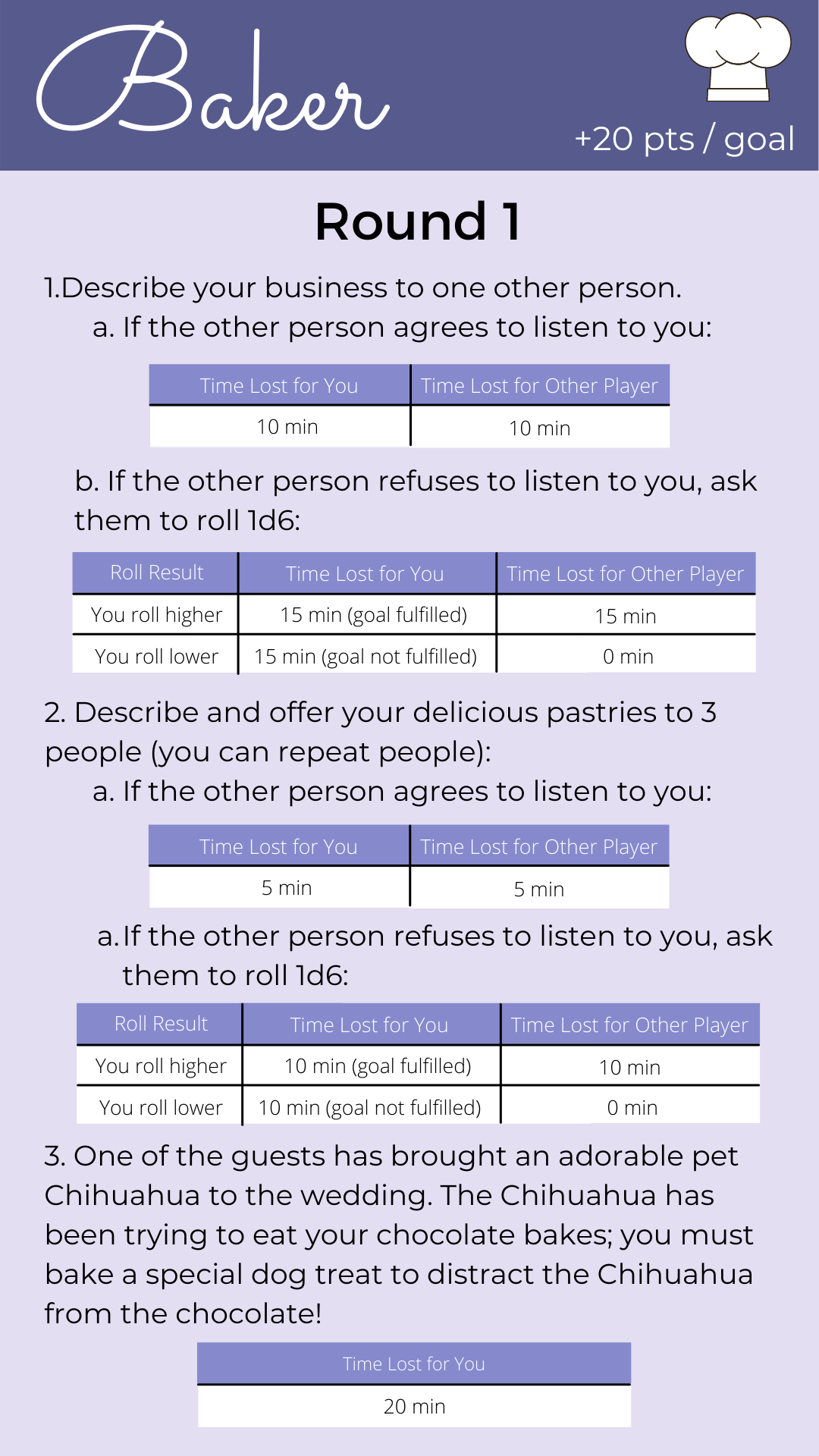
Social Goal Card (see all Social Goal Cards here):

Wedding Goal Card (see all Wedding Goal Cards here):

Points Tokens (from top to bottom: Economic goal token (from left to right: front & back), Social goal token (L to R: front & back), Wedding goal token (L to R: front & back)):

Next Steps
The core elements of the game have been finalized. However, if we were to continue playtesting and fine tuning the game, our next step would be to:
- Allow players to interrupt other players once per round if they are talking too long. In playtest #3, we noticed that some players were having to wait a long time for their turn because those that went earlier were taking up too much time. To compensate for this, we would permit players to interrupt one player per round if the group feels like they’re taking too long.
- Round 3 goals should be more collaborative. During our final playtesting, we received feedback that the wedding goals in round 3 lacked social interaction compared to the previous rounds. To address this, we would redesign the wedding goals for round 3 so that they must be completed in pairs.
We hope you enjoy playing Hitched Without a Hitch!


